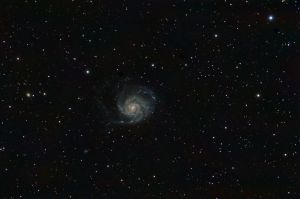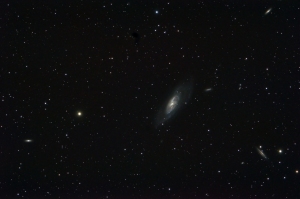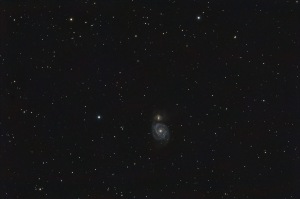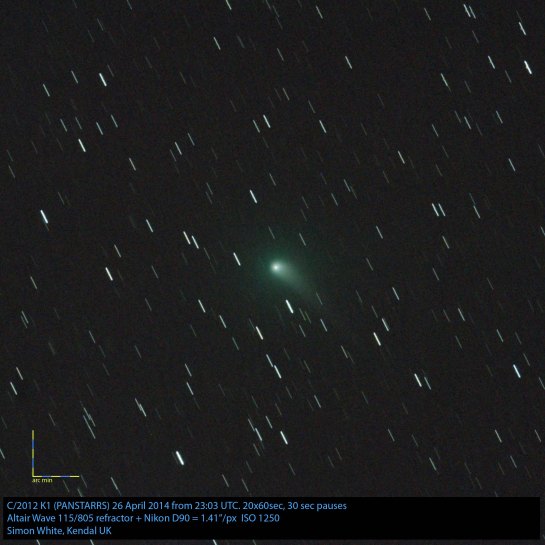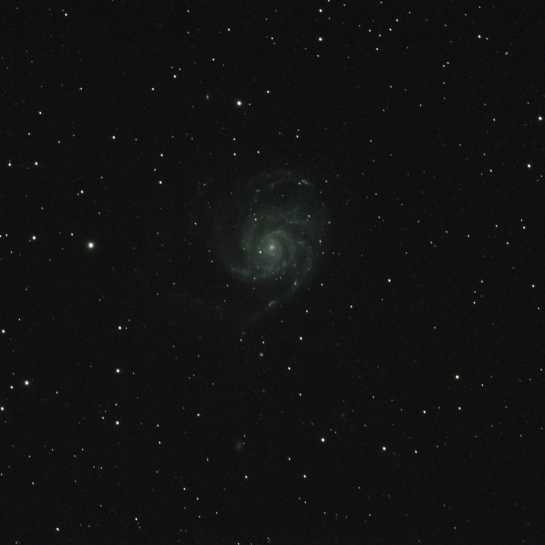Not sure why I haven’t posted for a while, as there was a spell in April when we had a string of back-to-back clear nights. There were opportunities galore to capture springtime galaxies, and I found new locations such as Elterwater carpark to take advantage of dark skies.
17 April, with some cloud in the east, I headed to the centre of the Lake District in pursuit of “Markarian’s Chain” using my new protocol of guided 10-minute exposures. Elterwater is a small village in the Langdale valley, but has a good accessible hard standing carpark where I set up my system. The netbook computer guides for only a couple of hours on its old battery, so once it’s up and running I have to get on with it.
The target was Markarian’s Chain of galaxies just east of Leo, and I managed six frames of 10 minutes each before the clouds chased me down. One frame was a little hazy, so the result is a stack of 5×10 minutes. Darkness was good, but disadvantages of Elterwater include some very bright outside lights on tourist rental properties, and large camper vans using the carpark for overnight stays. Also it is low altitude and a bit of a bowl for mist and condensation.
That said, there are 25 or more galaxies easily seen in this photo, and the stats are mind-boggling. Most objects in this frame are over 50 million light years away, and the galaxy in the bottom left corner (M87) is a million light years from M84 at the right hand end of the chain. Galaxy NGC4388 at bottom right (the “smile” on the face at the front of the chain) is 11th magnitude, which makes it less than 1% of the brightness of the faintest object visible to the naked eye from a dark location. The galaxies are gravitationally bound to one another, despite the incomprehensible distances involved. All that with a Nikon D90!
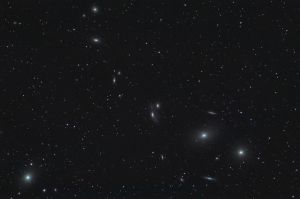
Markarian’s Chain: M84, M86 and others, plus M87 in the lower left corner, all in the Virgo Cluster
Nikon D90 on Altair Wave 115/805 (f/7), ISO 400
50 minutes: 5 frames of 10 minutes each.
On the night of 18 April, M101 was at zenith, captured here in 9 frames guided at 10 minutes each. That’s a total of an hour and a half on one galaxy, which is a lot for me (until now!). 10 minutes is fantastic for light gathering, but pushes the boundaries of long exposure v potential for disturbance. If a car drives past, or if a strong gust of wind nudges the system – or even if the guiding software momentarily loses sight of the guide star – then the whole 10-minute frame is spoiled. These were taken in the long layby on the A591 outside Staveley, which is sheltered but by no means unused, and I was fortunate that there was almost no traffic that night.
On 21 April, I was back on the Shap Road with fellow members of the Eddington Astronomical Society, and my target this time was M106, again at zenith. Thirteen frames of 10 minutes were reduced to nine on closer inspection (gusts of wind spoiled four), so this is also a stack of 9×10 minutes. In calm conditions I seriously wonder whether the DSLR could cope with 15 minutes per frame; with the ISO at a comfortable 400, there is very little by way of glow from the sensor. What level of detail might be possible with three or four hours total exposure?
Finally, on 26 April, a quick experiment from my own back yard. With high buildings and trees obstructing a clear view of the sky, it’s not possible to go through the star alignment process on the GOTO handset, so I’m restricted to polar-aligning the mount by eye. I hoped that with 5-minute frames, the guiding system might smooth out the alignment error. Here’s 20×5 minutes on M51, with the ISO wound up to 800, suggesting this has some promise. There’s light pollution from next door’s uncurtained landing window, so a light pollution filter might be a useful addition to the armoury.
